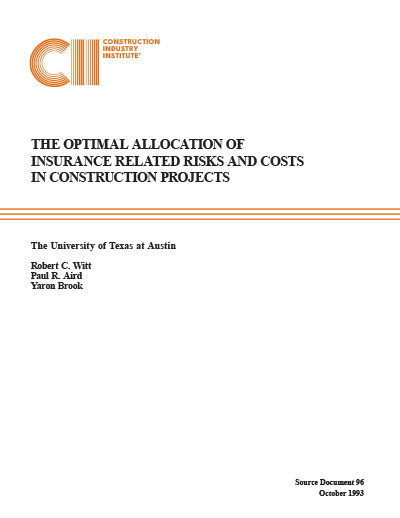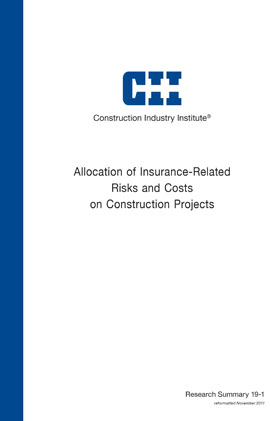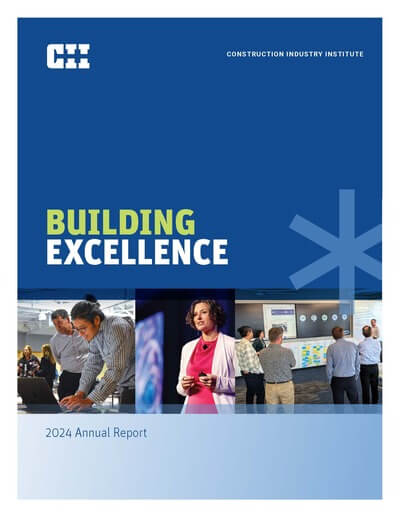
The Optimal Allocation of Insurance Related Risks and Costs in Construction Projects
Commercial Liability Insurance Crisis
The commercial liability insurance crisis of the mid-1980’s caused risk managers in the construction industry to realize that they could not make reasonably accurate predictions of future costs or the availability of liability insurance. This realization motivated the development of an Insurance Task Force by the Construction Industry Institute to determine ways to reduce the total cost of risk associated with construction projects in the future.
Chapter 1 examines this price and availability crisis by exploring the possible explanations for the dramatic changes in the liability insurance marketplace. It is shown that a combination of several economic forces and an expanding tort-liability system led to the crisis which had an adverse economic impact on the construction industry. Since underwriting cycles will continue to occur in the insurance market, risk managers need to be prepared to deal with future changes and crises by strategically planning to make use of alternatives to purchasing insurance from commercial insurance carriers.
TThe commercial liability insurance crisis was a fundamental reason for the creation of an Insurance Task Force within the Construction Industry Institute. The Task Force worked with an academic team to develop this report in order to help all parties involved in the construction industry reduce the total cost of risk by implementing better methods for handling and allocating risk on construction projects.
Basic Risk Management and Insurance Concepts
Chapters 2 and 3 provide a review of basic concepts and definitions related to risk management and insurance in order to provide a conceptual foundation for the study. The goal of risk management should be to manage and reduce the total cost of risk. The total cost of risk is the sum of: (1) net costs for insurance (premium payments less amounts received back from insurers for the reimbursement of losses and loss adjustment expenses), (2) losses and loss adjustment expenses, (3) costs for loss control and safety, and (4) administrative costs of risk management. Culturally, it is important to focus on the total cost of risk for an entire construction project in order to reduce this cost, rather than have individual parties in a project only protect their own economic interests.
The risk management process is shown to include the following steps: (1) risk identification, (2) risk measurement, (3) selection of the appropriate risk management “tool,” and (4) implementation and monitoring. There are several options, or “tools,” which can be used in this risk management process. For example, risks can be avoided, retained, or transferred to another party. In addition, risks can be managed by investing in loss control measures.
Insurance is only one of several options to consider for risk financing purposes. Chapter 3 provides an economic overview of the insurance mechanism. There are several requirements that should be met ideally in order for a risk to be insurable. The insurance mechanism involves both risk transfer and risk distribution. The economic goal of insurance is risk reduction. Insurance can be purchased under several different rating plans, which essentially determine the rate that will be paid for the coverage. The options include guaranteedcost insurance and other rating plans which are loss sensitive, Such as experience-rated and retrospectively-rated policies.
Market Determination of Insurance Prices
Chapter 4 provides a foundation for understanding and showing how insurance rates are determined in competitive markets. Insurers must predict future expected losses and expenses in order to set competitive and reasonable premiums. By pooling loss exposures, insurers can be reasonably certain that actual losses will be close to expected losses. It is shown that a pure premium (the pure loss portion of an insurance premium) for insurance can be determined by multiplying the expected claim frequency by the expected claim severity for a given loss exposure. The pure premium is then increased by an expense loading factor in order to determine the base (or gross) insurance rate to be charged by an insurer.
Chapter 4 describes many social, legal, and economic factors that influence the rate charged for insurance, including inflation, interest rates, the legal environment, policy provisions, and others. While some of these factors are beyond the control of the insured, other factors can be controlled and managed in order to lead to lower insurance costs and prices.
Economic Role of Insurers
Chapter 5 examines the economic role played by insurance companies in the economy and construction industry. An insurer is shown to be a financial intermediary which receives premiums from insureds and then pays for losses as they occur. The different types of insurance companies and the different marketing systems used for insurance are also discussed. The various operations within insurance companies, such as underwriting, claim settlement, investments, and accounting are also presented. The chapter concludes by examining reinsurance, which is essentially insurance for insurance companies. Reinsurance spreads risk and is shown to serve many useful purposes for insurers, as well as for the insurance market in general.
Insurance Markets and Alternatives
The various markets in which insurance can be obtained are evaluated in Chapter 6. While a large portion of total insurance premiums are placed with admitted insurance companies which are highly regulated in most states, there are several alternatives that should be considered. The excess and surplus lines market can be useful for many risks because it is not subject to rate and form regulation imposed upon the admitted market. It is also shown that the market for self-insurance, and modified forms of self-insurance has been growing rapidly in the past decade.
All insurance alternatives should be considered for risk-financing purposes before purchasing insurance through the admitted market. The advantages and disadvantages associated with all these alternatives need to be analyzed and evaluated in the risk-management decision process. Risk managers and chief financial officers in the construction industry need to consider the costs and benefits of all alternatives for treating risk.
Economic Evaluation of Insurance Markets and Alternatives
In Chapter 7, economic aspects of the various insurance markets and alternatives are discussed. It is shown that all of the markets previously described must compete with one another for premium dollars and market share. The admitted market has some advantages in that many insureds are contractually required to purchase insurance through that market. In addition, most states impose some restrictions on accessing less regulated alternative markets. The admitted market is subject to various insurance form and rate regulations, which tend to increase costs.
Large commercial insureds can usually find ways to access alternative insurance markets, which are generally not subject to form and rate regulations. If the admitted market is not competitive in terms of insurance forms or prices, many large insureds will have an economic incentive to abandon the admitted market and begin using alternative markets. In addition, if all the commercial insurance markets become uncompetitive, Insureds have the option of becoming self-insured. As a consequence, insurance markets remain competitive due to insurer fears of losing market share.
Insurance brokers can help insureds search all possible markets in order to obtain the best risk financing program available at the least cost for a given loss exposure. In essence, brokers are information intermediaries.
Risk Management in the Construction Industry
Specific aspects of risk management in the construction industry are examined in Chapter 8. It is shown that the construction industry poses many unique challenges for the risk manager. Several risk management options are available for most loss exposures. The construction industry could lower total costs by increasing investments in safety and loss control measures.
It appears that there is a tendency for owners to transfer risk to contractors and then require the contractor to purchase insurance. This may not be the most cost effective method of risk financing in many cases.
Given the large amount of money spent on risk management and insurance in the construction industry, greater use of risk management information systems (RMIS) would help risk managers to make better informed risk retention and transfer decisions.
Risk Allocation in the Construction Industry
Chapter 9 examines the economic nature of risk allocation in the construction industry. The goal of the chapter is to develop a framework for the optimal allocation of risk among the various parties involved in construction projects. This optimal level is achieved by balancing the sometimes conflicting needs of efficiency and equity.
An efficient allocation of risk transfers risk to the party that can bear that risk at the lowest cost (the least-cost risk bearer), while equity considerations call for risk to be shifted to the party that controls the loss exposure. By balancing these sometimes conflicting goals, the total cost of risk for a project can be minimized, other things being equal.
An Economic Analysis of Hold-harmless Agreements
Contractual risk transfer is very common within the construction industry. Hold Harmless agreements are discussed in Chapter 10. The various forms of hold-harmless agreements and legal issues surrounding these agreements are assessed. The chapter provides an economic analysis of hold-harmless agreements and concludes that the limited-form agreement tends to be the most effective at reducing long-run risk management costs. While a broad-form agreement may lower one parties short-run costs, it is shown that this is not the optimal approach to be taken to minimize the long-run cost of risk.
Other mechanisms which can be used to create an efficient and effective transfer of risk are also examined and assessed. These include insurance, waivers of subrogation, and the naming of additional insureds on insurance policies. If all parties work together, the total cost of risk for a construction project can be minimized while equitably protecting the interests of all parties. Trust and cooperation will be required in order to achieve this objective, which will probably require a major cultural change in attitudes.
Insurance in the Construction Industry
Even though there are many alternatives, insurance is the most common method of risk financing for the construction industry. Chapter 11 is devoted to specific aspects of insurance within this industry. The primary coverages discussed are workers’ compensation insurance, general liability insurance, and builders risk insurance. These coverages are reviewed and evaluated to show how better coordination and utilization of these coverages could help to lower the total insurance costs for the construction industry.
Wrap-up insurance programs are also analyzed in this chapter. It is shown that the coordination of insurance programs can be very helpful in lowering total costs. However, these programs require a high level of trust and cooperative management in order to be cost effective and efficient. Potential conflicts of interest among all concerned parties must be resolved in a fair and efficient fashion.
Duplicated Risk Financing and Insurance Issues
Chapter 12 addresses a variety of insurance-related issues. The primary topic discussed is duplicated risk financing. It appears that such duplication is a common problem for the construction industry. There are both advantages and disadvantages associated with duplicated risk financing. Owners and contractors need to work together to reduce these duplicated efforts and costs in order to minimize the total cost of risk.
Other issues examined in this chapter include selecting the appropriate party to purchase insurance for the project and choosing a rating plan for the insurance policies purchased.
CII Insurance Surveys
The results of the insurance surveys sent to CII members are summarized in Chapter 13 through 15. In addition, the key results from the surveys are discussed within the relevant chapters throughout this report. Overall, the survey showed that owners and contractors have substantially different views on many insurance related issues, such as duplicate risk financing. These differences in perception are partially resolved by the analysis in the research project, but deserve further investigation in order to assure that the optimal risk financing program is utilized.
Complete responses to the project specific questionnaires were not obtain Apparently, many owners and contractors do not have the necessary and convenient access historical information on insurance costs and construction related accident losses. Therefore, the glaring need for risk management information systems became apparent. Intelligent risk management decisions for minimizing the total cost of risk cannot made without critical information.
Conclusions and Recommendations
Some of the major conclusions and recommendations reached in this report will be briefly reviewed below. This section is not intended to provide a complete listing of all the recommendations of this study for the CII Insurance Task Force, but normally focuses on some highlights.
In order for the construction industry to implement these proposed changes, it will require active involvement by high-level executive management to bring about a cultural change in terms of risk management philosophies for many large contractors and owners. If these changes were implemented on a wide-scale, the construction industry could significantly lower it total cost of risk. This would help to improve the efficiency of the construction business in the United States and help to develop a competitive advantage in international markets for both contractors and owners. The basis and rationale for the recommendation specified below have been developed in the chapters, so they will not be repeated here.
- First of all, it is essential that executive-level management become aware of the total cost of risk and the potential long-run savings that would result from changing current risk management and risk-financing practices. It appears that many risk managers have a difficult time convincing major executives that changes are needed in order to reduce the total cost of risk.
- The various parties involved in a construction project need to cooperate in designing contractual-risk-transfer agreements in order to achieve the optimal level of risk allocation discussed in Chapter 9. This includes allocating risk on both an equitable an efficient basis. From such an economic perspective, this means that it would no longer be desirable to shift excessive amounts of risk to those parties with weak bargaining power. Excessive risk shifting leads to excessive costs for all parties in the long-run and tends to reduce the competitiveness of the construction industry in the United States and internationally. Efficient risk shifting is needed in order to minimize the total costs of risk in the construction industry.
- The construction industry should become more aware of insurance cycles and be prepared to deal with future crises, similar to the commercial liability insurance crisis of the mid 1980’s. Strategic planning will probably lead to increased usage of alternative insurance markets and the expanded use of risk retention mechanisms. Failure to plan strategically for future underwriting cycles will result in high and unnecessary insurance costs.
- More attention should be given to the risk management options other than insurance. For instance, some risks may be well suited for risk retention while others may be avoided entirely. Excessive reliance on insurance for risk-financing purposes, including contractual requirements forcing the purchase of insurance, can lead to higher overall costs of risk management in the construction industry.
- Significant funds should be invested in loss control and safety programs. These alternatives to purchasing insurance can generate significant savings. Many such safety investments can be offset by lower direct losses. However, given that the indirect or consequential costs of losses can be several times larger than the direct costs, the total benefits of reduced losses can be dramatic. It should also be noted that claims in one area, such as workers’ compensation, often lead to claims in other areas, such as liability claims and high-cost litigation. The elimination of cascading claims and litigation costs can result in significant long-term savings.
- The construction industry needs to become more aware of how the insurance industry operates and how insurance prices are set. Rather than simply blaming insurance companies for rising rates, it is important for the construction industry to work with insurers to control the factors driving insurance costs, as discussed in Chapter 4. The insurance industry can provide valuable benefits to the construction industry through its loss control and risk reduction services. Cooperation between the construction and insurance industries Could lead to lower costs for insurance.
- All parties need to work together in order to achieve meaningful and effective tort reform. It is also important to be aware of the intense competition among the various insurance markets and to press for less rate and policy form regulations which tend to stifle competition in insurance markets. Increased levels of regulation in the insurance industry tend to increase, rather than decrease, the total costs for insurance. This is especially true for larger, commercial insureds. Regulators have no control over the fundamental economic factors driving insurance prices. They tend to focus on symptoms (rising prices) rather than causes (rising costs of goods and services purchased by insurance claim payments).
- It is imperative that the construction industry increase its use of risk management information systems (RMIS) in order to become more efficient, as discussed in Chapter 8. RMIS are essential to enable risk managers and other financial executives to make informed decisions about the expected impact of various alternative risk financing programs. The use of RMIS will create large databases of cost information on construction industry losses and premiums and help in the quest to minimize the total cost of risk, which is needed to enhance the efficiency and competitiveness of the construction industry in the United States and internationally.
- Given the prevalence of hold-harmless agreements within the construction industry, owners and contractors need to become more informed about the consequences associated with the various forms of these risk-allocation agreements. The limited-form agreement tends to be the most effective at reducing long-run risk management costs. While a broad-form agreement may lower one parties short-run costs, it is not the optimal approach to use to minimize Ion-run risk costs. Owners should not force contractors to accept unreasonable risk transfer contracts and contractors should not accept broad risk transfers simply to get new business which would tend to increase total risk costs in the long run. The focus of contractor and owners needs to be on the long-run goal of minimizing the total cost of risk for an entire construction project and ultimately the construction industry. Once these savings have been achieved, the cost savings will benefit all parties. That is, everyone will be compensated for helping lower total risk costs and be given incentives to keep future costs down to a level which is optimal in a least-cost sense for the construction industry.
- Risk managers need to become more aware of the usefulness of alternative rating plans for insurance. Loss sensitive plans can help to lower costs below what is available through guaranteed-cost plans because of safety-incentive effects. In addition, large construction projects should always consider the use of wrap-up insurance programs as a potential cost-saving option. These coordinated insurance plans help foster a cooperative attitude among contractors and owners, and tends to lower the total cost of insurance for a project. A substantial amount of trust and cooperation is needed, however, to effectively implement such plans. Thus, wrap-ups are definitely not suited for all construction projects, but they should be considered for large projects involving several contractors.
- Excessive levels of duplicated risk financing need to be reduced to the optimal level, as noted in Chapter 12. There are many ways of protecting all parties economic interests in a construction project without duplicating risk-financing efforts. For example, it is suggested that owners should limit the contractor’s liability for damage to the owners existing property. Such changes could have a dramatic cost-reducing impact on the total cost of risk for the entire construction industry through the reduction of duplicated risk financing. Again, trust and cooperation among all parties in the construction industry will be needed in order to minimize the total cost of risk and to make the construction industry more competitive and efficient in the United States and internationally.
More attention should be given to the risk management options other than insurance. The following five steps are discussed in detail within the research:
- Risk Identification
- Risk Measurement
- Risk Management Tools (selection)
- Implementation
- Monitoring/Evaluation



